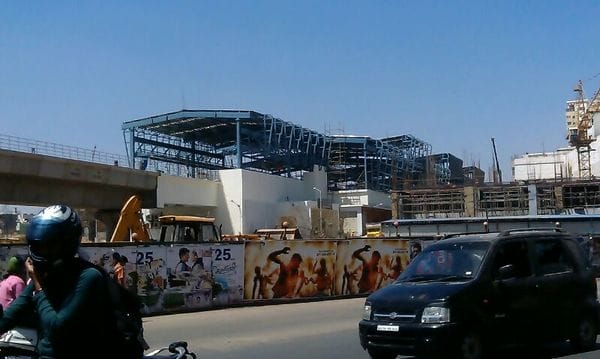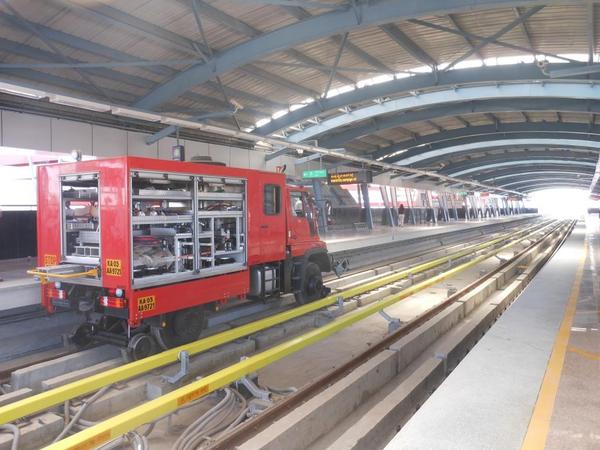It’s official. Namma Metro Reach 3 and 3a services from Malleshwaram to Peenya in namma Bengaluru will open for public use from March 1st, 2014. Urban and Land Transport and District in-charge Minister Ramalinga Reddy along with Bangalore Metro Rail Corporation Limited (BMRCL) Managing Director Pradeep Singh Kharola announced this on February 24th, 2014, at a press conference held at Rajajinagar Metro Station.
Ramalinga Reddy said: “On 28th February evening at 6 pm, Railway Minister Mallikarjun will inaugurate this line. From 1st March 6 am onwards the service will be open for public.” The good news for the users is the last train will run at 11pm, unlike MG road to Baiyappanahalli stretch that has the last train running at 10 pm.

Sampige Road Metro station (Swastik) at the last leg of completion. Pic: Nikita Malusare
BMRCL MD Kharola claimed that all the stations were ready for use, though the Sampige Road Metro station (Swastik station behind Mantri Square) is yet to be ready fully. The 10-km stretch from Sampige to Peenya Industrial Area is ready to host six-coach trains. However, initially three-coach trains with carrying capacity of 975 passengers will start the service. The frequency of the train will be maintained at every 10 minutes. This frequency will be increased depending on the number of travellers.
The entire stretch that usually takes 45 minutes to cover by road, will be covered in 18 minutes with Metro, with 30-second halt on each station. Commissioner of Rail Safety (CRS) has permitted a speed of 80 km / hour on this stretch. As many as 12 trains are ready with safety clearance.
Talking about the possible hike in the price that BMRCL has been contemplating for long, Kharola said, “BMTC charges Rs.45 for a 10km stretch. Metro will cost only Rs.23.” Smart card users will enjoy a 17% discount for the same distance, that is Rs. 19.
|
Stations |
Tariff |
|
Sampige to Srirampura |
Rs. 10 |
|
Sampige to Kuvempu Road |
Rs. 13 |
|
Sampige to Rajajinagar |
Rs.14 |
|
Sampige to Mahalakshmi |
Rs.16 |
|
Sampige to Sandal Soap Factory |
Rs.17 |
|
Sampige to Yeshwanthpur |
Rs.19 |
|
Sampige to Yeshwanthpur industry |
Rs.21 |
|
Sampige to Peenya |
Rs.23 |
|
Sampige to Peenya industry |
Rs.23 |
CCTVs, emergency vehicle at place
To beat the primary concern of passenger safety, 50 to 60 surveillance cameras are installed at every station. Apart from this, 29 passenger lifts and 46 escalators are built on the entire line. BMRCL is also looking forward to rent the shops in order to recover its revenue.
BMRCL has purchased a Road-Cum-Rail vehicle at a cost Rs. 3 crores for the Reach 3 and 3a. It will be stationed at Peenya depot. This rescue vehicle is used in case of any accidents like derailment of train and other emergencies. Baiyappanahalli station already has one such Road-Cum-Rail Vehicle.
Road-cum-rail service vehicle Pic: Nikita Malusare
Metro – what next?
-
Peenya to Nagasandra (Reach 3B – 2.5 km) stretch and Byappanahalli to Mysore road stretch will be ready before the end of 2015.
-
The tunneling work between North-South line between Sampige Road and National College (Underground – UG1 – 4 km) is expected to be completed by September or October 2014.
-
East-West tunnel running between M G Road and Magadi Road (Underground – UG2 – 4.8 km) will be completed in next 40 days.
-
The most controversial Jayadeva realignment will start in next 15 days. Kharola said that the drawings are being finalised.
‘Still working on feeder service’
Talking about lack of buses for feeder service in Baiyappanahalli and M G Road stations, Ramalinga Reddy gave assurance that the bus feeder service will be increased in various stations. MD BMRCL said, they have been carrying out talks with BMTC to increase the feeder services.
One of the key loopholes in this reach is connectivity issue. A distance of 800 metres between from Sampige Station to Majestic will need to be covered by bus. Acknowledging the lack of connectivity, Kharola said that the BMTC is expected to increase bus rounds between Sampige Station to Majestic.
Parking won’t be an issue for two and three-wheeler riders, at Rajajinagar Metro Station (near Navarang) in particular. However, Ramalinga Reddy said that BMRCL is not responsible for parking – it is the BBMP.
Related Articles
BBMP plans to merge Silk Board elevated road with Metro line
MG Road Metro station to host puppet shows and workshops
What is so ‘top secret’ about Metro stations?
